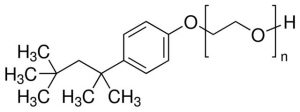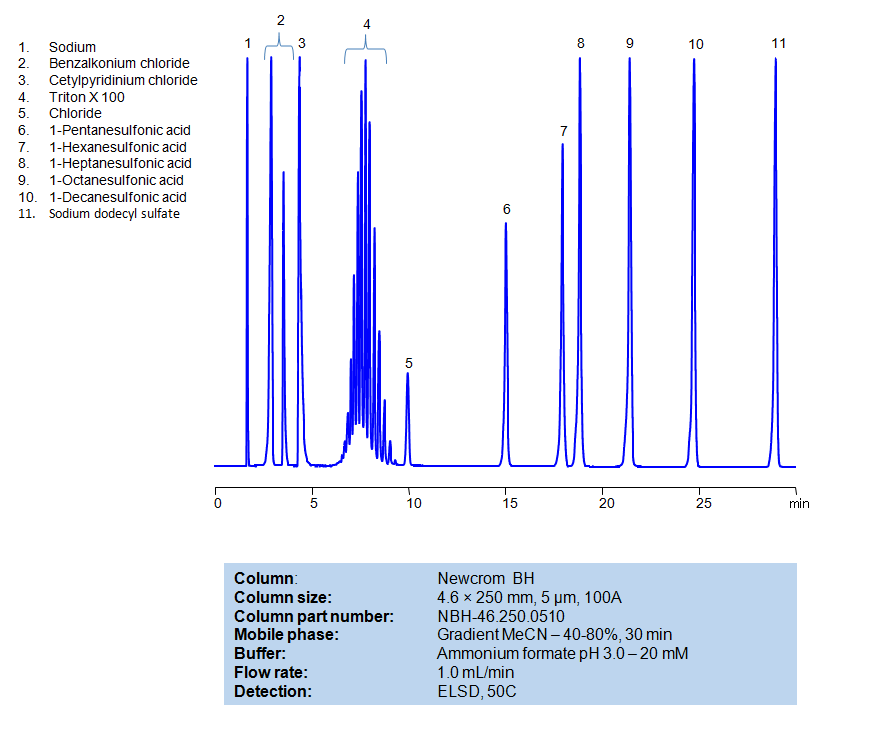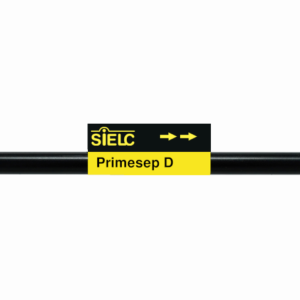| CAS Number | 9002-93-1 |
|---|---|
| Molecular Formula | C14H22O(C2H4O)n(n=9-10) |
| Molecular Weight | 647 |
| Synonyms |
|
Applications:
HPLC Method for Separation of Hydrophobic, Cationic, Nonionic and Anionic Surfactants on Newcrom BH Column
July 10, 2023
HPLC Method for Separation of Hydrophobic, Cationic, Nonionic and Anionic Surfactants on Newcrom BH by SIELC Technologies
Separation type: Liquid Chromatography Mixed-mode
Surfactants, also known as surface-active agents, are compounds that lower the surface tension (or interfacial tension) between two liquids or between a liquid and a solid. Surfactants may act as detergents, wetting agents, emulsifiers, foaming agents, or dispersants.
They are often classified according to the charge of the polar head group:
Anionic Surfactants: These surfactants have a negative charge on their polar head group. Common examples include soap, sodium laureth sulfate, and sodium lauryl sulfate. They are commonly used in detergents and shampoos due to their ability to emulsify oils and hold dirt in suspension, so it can be rinsed away.
Cationic Surfactants: These surfactants have a positive charge on their polar head group. Examples include cetyltrimethylammonium bromide (CTAB) and benzalkonium chloride. These are often used as antiseptics and can also be found in hair conditioners because they reduce static cling.
Nonionic Surfactants: These surfactants have no charge on their polar head group. Examples include alcohol ethoxylates, nonylphenol ethoxylates, and polysorbates. Nonionic surfactants are often used in laundry and dishwasher detergents.
All compounds can be retained, separated, and analyzed using a reverse-phase Newcrom BH, 4.6 x 250 mm, 5 µm, 100 A, dual ended column. The mobile phase for this method consists of water, acetonitrile (MeCN), and Ammonium formate, which serves as a buffer. This analytical method can be detected with an Evaporative Light Scattering Detector (ELSD) or any other evaporative detection method (CAD, ESI-MS).
High Performance Liquid Chromatography (HPLC) Method for Analysis of Benzalkonium chloride, Cetylpyridinium Chloride, Triton X100, 1-Pentanesulfonic acid, 1-Hexanesulfonic acid, sodium salt, 1-Heptanesulfonic acid, 1-Decanesulfonic acid, Sodium dodecyl sulfate, 1-Octanesulfonic acid
Condition
| Column | Newcrom BH, 4.6 x 250 mm, 5 µm, 100 A, dual ended |
| Mobile Phase | Gradient MeCN -40-80%, 30 min |
| Buffer | Ammonium formate pH 3.0 – 20 mM |
| Flow Rate | 1.0 ml/min |
| Detection | ELSD, 50C |
Description
| Class of Compounds | Aliphatic sulfonic acid |
| Analyzing Compounds | Benzalkonium chloride, Cetylpyridinium Chloride, Triton X100, 1-Pentanesulfonic acid, 1-Hexanesulfonic acid, sodium salt, 1-Heptanesulfonic acid, 1-Decanesulfonic acid, Sodium dodecyl sulfate, 1-Octanesulfonic acid |
Application Column
Newcrom BH
Column Diameter: 4.6 mm
Column Length: 250 mm
Particle Size: 5 µm
Pore Size: 100 A
Column options: dual ended
1-Heptanesulfonic acid
1-Hexanesulfonic acid, sodium salt
1-Octanesulfonic acid
1-Pentanesulfonic acid
Benzalkonium chloride
Cetylpyridinium Chloride
Sodium dodecyl sulfate
Triton X100

HPLC Separation of the Nonionic Surfactant Triton-X-100
July 11, 2012
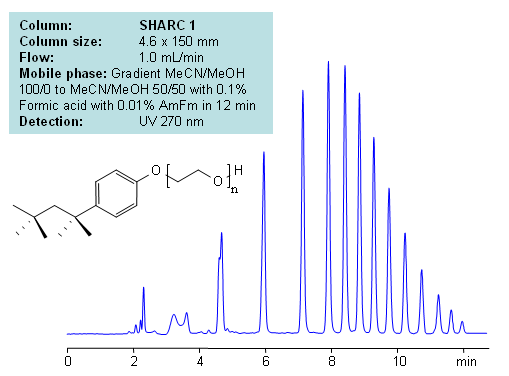
Triton X-100 is a non-ionic surfactant which has a hydrophilic polyethylene oxide group (on average it has 9.5 ethylene oxide units), and a hydrocarbon lipophilic or hydrophobic group. SHARC 1 HPLC columns are used to separate oligomers of Triton X-100. Separation is achieved in anhydrous conditions by hydrogen bonding using acetonitrile (ACN) and methanol (MeOH) as the mobile phase with formic acid and ammonium formate (AmFm) as buffer. This method can be used in determination of oligomers of Triton X-100 in detergents, liquid, paste, and powdered cleaning formulations. This separation can be monitored with almost any detection technique (UV, ELSD, LC/MS, RI, CAD, etc.)
| Column | Sharc 1, 4.6×150 mm, 5 µm, 100A |
| Mobile Phase | Gradient MeCN/MeOH – 100/0- 50/50%, 12 min |
| Buffer | Formic Acid 0.1% , AmFm – 0.01% |
| Flow Rate | 1.0 ml/min |
| Detection | UV, 270 nm |
| Class of Compounds |
Nonionic Surfactant, Hydrophobic, Ionizable |
| Analyzing Compounds | Triton-X-100 |
Application Column
SHARC 1
The SHARC™ family of innovative columns represents the first commercially available columns primarily utilizing separation based on hydrogen bonding. SHARC stands for Specific Hydrogen-bond Adsorption Resolution Column. Hydrogen bonding involves an interaction or attraction between a bound hydrogen atom and molecules containing electronegative atoms, such as oxygen, nitrogen, and fluorine.
Select options
HILIC Separation of Surfactant Triton X-100 on Obelisc N Column
August 22, 2008
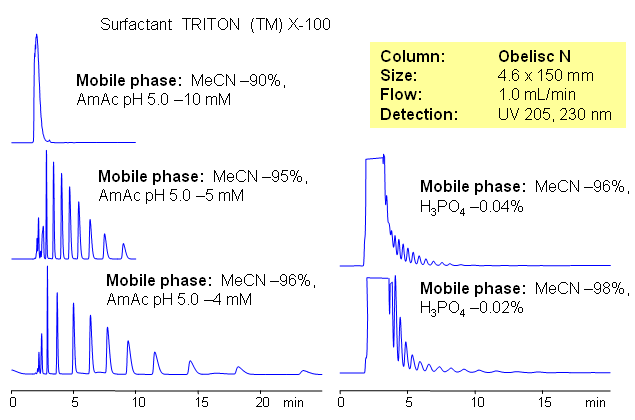
Triton X-100 is a non-ionic surfactant which has a hydrophilic polyethylene oxide group (on average it has 9.5 ethylene oxide units), and a hydrocarbon lipophilic or hydrophobic group. Obelisc N HPLC columns are used to separate oligomers of Triton X-100. Separation is achieved by hydrophilic interaction chromatography. This method can be used in determination of oligomers of Triton X-100 in detergents, liquid, paste, and powdered cleaning formulations. This separation can be monitored with almost any detection technique (ultra-violet, ELSD, LC/MS, RI, CAD, etc.)
| Column | Obelisc N, 4.6×150 mm, 5 µm, 100A |
| Mobile Phase | MeCN/H2O |
| Buffer | AmAc pH 5.0 |
| Flow Rate | 1.0 ml/min |
| Detection | UV 250, 230nm |
| Class of Compounds |
Surfactant, Hydrophobic, Ionizable |
| Analyzing Compounds | Triton X-100 |
Application Column
Obelisc N
Column Diameter: 4.6 mm
Column Length: 150 mm
Particle Size: 5 µm
Pore Size: 100 A
Column options: dual ended

HPLC Separation of Surfactants
November 21, 2006
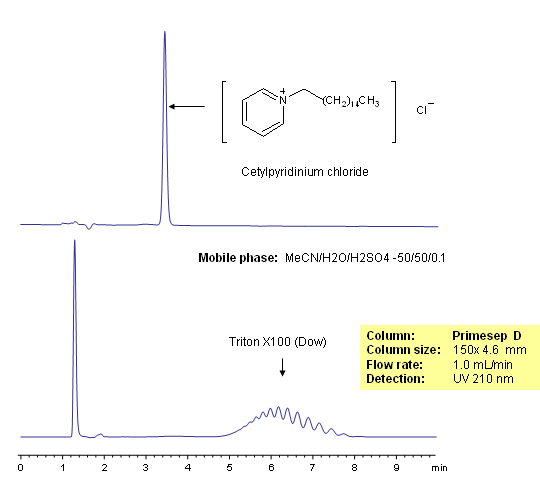
Surfactants are molecules that contain both hydrophilic and hydrophobic groups, usually in the form of a hydrophilic head and a hydrophobic tail. Surfactants are used in detergents where they can form micelles around hydrophobic dirt molecules and wash them away. Triton X-100 is a surfactant with a hydrophilic polyethylene oxide chain that can be separated on a Primesep D reverse-phase HPLC column based on the number of oxide units in the chain. The mobile phase is water, acetonitrile (MeCN, ACN) and sulfuric acid as buffer. UV detection at 210nm.
| Column | Primesep D, 4.6×50 mm, 5 µm, 100A |
| Mobile Phase | MeCN/H2O – 50/50% |
| Buffer | H2SO4- 0.1% |
| Flow Rate | 1.0 ml/min |
| Detection | UV 210nm |
| Class of Compounds |
Surfactant, Hydrophobic, Ionizable |
| Analyzing Compounds | Triton X-100, Cetylpyridinium Chloride |
Application Column
Primesep D
The Primesep family of mixed-mode columns offers a wide variety of stationary phases, boasting unprecedented selectivity in the separation of a broad array of chemical compounds across multiple applications. Corresponding Primesep guard columns, available with all stationary phases, do not require holders. SIELC provides a method development service available to all customers. Inquire about our specially-tailored custom LC-phases for specific separations.
Select optionsTriton X100

